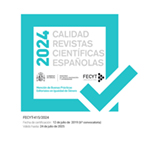Open Peer review Vol. 21. N.1
"Under the Sea"
Ariel Avissar
Section: Videoessays
Reviewer A:
Please, comment on the most relevant aspects (positive points and areas to improve) of the reviewed videoessay.
‘Under the Sea’ is a deft and evocative piece of videographic criticism, its brevity and apparent simplicity working to belie a density of meanings concerning rage, gendered violence and forms of horror produced by patriarchy. Indeed, the audiovisual essay is a masterful example of how much can be achieved, in both argumentative and affective terms, in a short of time and with close attention to relationships between sound and image. The audiovisual essay makes its argument through a striking aesthetic deformation of The Little Mermaid, stripping away the film’s colour to create a stark image through which the violence of the film is revealed and amplified. The image becomes abstracted, and glitchy in places, which heightens the force of Triton’s rage-fuelled movements and their impact on Ariel, her body fragmented and shadowy; a bloodless but no less impactful body horror. This aesthetic treatment breaks the smoothness of the film’s animation, filling the screen with the rupture and vulnerability of the female body. The soundtrack further complicates the effect of the image, working in contrast as its fluidity jars with the ragged explosions onscreen to confuse the possibilities of weight and force, while its high-pitched glissandos complement the dramatic movement of bodies. The audiovisual meeting of The Little Mermaid and Under the Skin thus creates a disturbing but richly intertextual combination that provides in-the-moment sensory complexity, and an ongoing generation of meanings – for characters, narrative, genre, tone - in its implications.
Would you suggest any changes or make any recommendations to improve the quality of the videoessay?
No revisions necessary
Reviewer B:
Please, comment on the most relevant aspects (positive points and areas to improve) of the reviewed videoessay.
While I think the video is great and should be published as it is, I would recommend a few adjustments to the written statement. First, I'm not sure the introductory paragraph about the workshop at Bowdoin College is necessary. It might suffice to state that the video came out of a series of experiments with their personal explorations of childhood memories and parenthood. Second, the explanations of patriarchal (sub)text in the second paragraph might benefit from some further context (especially for those unfamiliar with the film). What, for example, makes Ursula the Sea Witch the "quintessential Other of patriarchy"? An extra sentence on the author's working definition of "patriarchy" within the context of the film might also help. Third, the author could add another sentence about Under the Skin, from which it takes the haunting and fascinating soundtrack, and about its relationship with Little Mermaid. Is there an interesting meta-connection or juxtaposition between the two films and their protagonists? Finally, in the very last sentence, "source material" refers to another level of source material, namely the source material of The Little Mermaid, which itself is the author's source material here. Assuming that this refers to the 19th-century fairytale on which the Disney film is based, that source should be mentioned explicitly and would strengthen the meta-connections that run through the video essay.
Would you suggest any changes or make any recommendations to improve the quality of the videoessay?
I'm only suggesting revisions to the written statement (see above)
Editorial Recommendations:
There are only two revisions that we request. 1) Your piece does not have a bibliography. It would become much stronger if you could list some key texts on the topic of rage at the end of your written statement, if not in your video essay, even if you haven't quoted them directly. 2) In your written statement, please remove the introductory paragraph about the workshop at Bowdoin College. It is too specific. It might suffice to state that the video came out of a series of experiments with their personal explorations of childhood memories and parenthood. Second, the explanations of patriarchal (sub)text in the second paragraph might benefit from some further context (especially for those unfamiliar with the film). What, for example, makes Ursula the Sea Witch the "quintessential Other of patriarchy"? An extra sentence on the author's working definition of "patriarchy" within the context of the film might also help. Third, the author could add another sentence about Under the Skin, from which it takes the haunting and fascinating soundtrack, and about its relationship with Little Mermaid. Is there an interesting meta-connection or juxtaposition between the two films and their protagonists? Finally, in the very last sentence, "source material" refers to another level of source material, namely the source material of The Little Mermaid, which itself is the author's source material here. Assuming that this refers to the 19th-century fairytale on which the Disney film is based, that source should be mentioned explicitly and would strengthen the meta-connections that run through the video essay.
The videoessay included some modifications before publication












